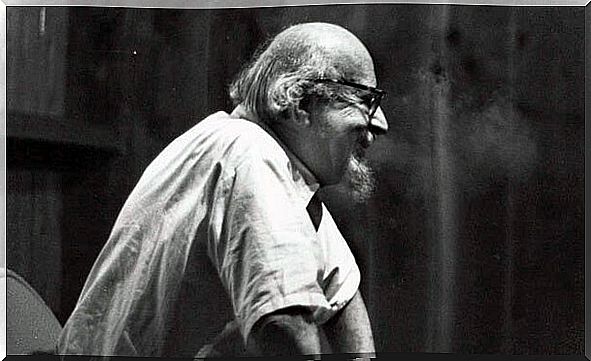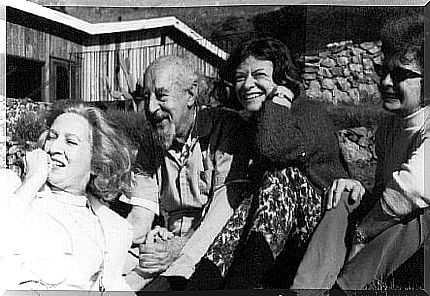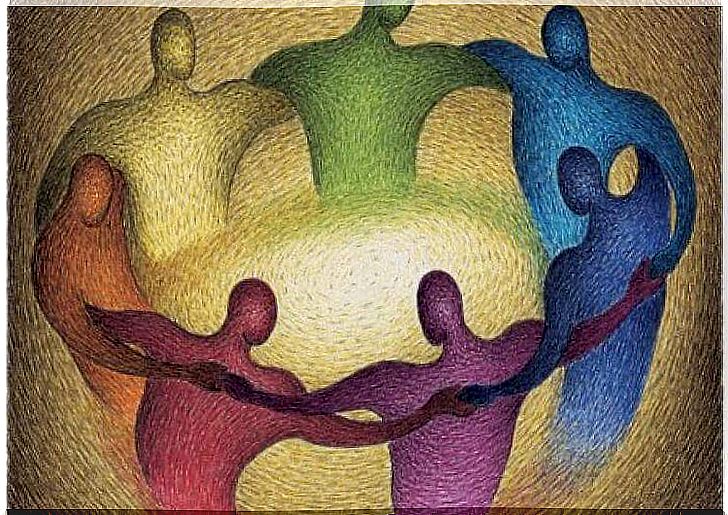Fritz Perls, A Curious Character In The History Of Psychology

Friedrich Salomon Perls, better known as Fritz Perls, was a German physician, psychiatrist and psychoanalyst who is considered the father of “Gestalt Therapy”. He was a fascinating and contradictory man who spent his entire life in intellectual circles, theoretical debates and travels around the world.
He was born in Berlin, on July 8, 1893, in a Jewish ghetto. He had two older sisters, Else and Grete. His father, Nathan, was a wine merchant and was frequently absent from home. His mother, Amalia, came from a petty bourgeois family and gave him a deep interest in art, which was with Perls all his life.
During an interview, Grete described her brother’s childhood as “wild.” He was a difficult child, although a good student. He entered secondary school at the Mommsen-Gymnasium in Berlin, a fairly severe educational center, where anti-Semitism was breathed in every corner. Perls was expelled when he was 13 years old. As punishment , his father forced him to work as an apprentice in a candy store.
Perls’s relationship with his father was always very conflictive. In his diary he defined his father as a hypocritical and double-minded man, who hated his mother and cheated on her with other women. So strong was this rejection by the father that Perls refused to attend his funeral.
Fritz Perls and his encounter with philosophy and psychoanalysis
On his own initiative, Fritz Perls resumed his studies at a humanist-oriented college, the Askaniches Gymnasium . At that time he met Max Reinhardt, a theater director who cultivated in him a love for that art, which lasted until his death.
Later, he began his studies in medicine. Shortly after the First World War began, Perls volunteered for the Red Cross. This experience marked him deeply, although he only spoke of it many years later in his biography entitled “Life in the throes of the pits: horror of living and horror of dying.”

In 1920 Fritz Perls received his medical degree from the Frederick Wilhelm University in Berlin. Then he specialized in Neuropsychiatry. Later he met the philosopher Friedlander, whose influence would be decisive for his work. In 1923 he decided to travel to New York, but returned frustrated because he was not allowed to validate his degree there because he did not know how to speak English. His discomfort led him to initiate psychoanalysis with Karen Horney. This fact changed his life.
Perls became fascinated with psychoanalysis and set himself the goal of becoming an analyst. However, he had to move to Frankfurt to fill the position of assistant with a psychiatrist named Kurt Goldstein, who worked with the postulates of Gestalt psychology. There he met Laura Possner, a student who became his wife two years later, despite the fact that her family and her psychoanalyst at the time, Clara Happel, disagreed with that relationship. Perls was 36 years old and Laura was only 24.
A year later he began practicing as an analyst in Vienna and in 1928 he became a full-time therapist in Berlin. Between this date and 1930, Perls did psychoanalysis with Eugen Harnick and later with Wilheim Reich. The latter had been a disciple of Freud himself, but had departed from his postulates. Much of the theory later developed by Perls was inspired by Reich’s approach.
The birth of Gestalt Therapy
After Hitler’s rise to power, Fritz Perls fled to Holland, but was not given permission to work there. After going through great hardships with his wife and newborn daughter, Ernst Jones helped him get a job as a didactic psychoanalyst in Johannesburg, South Africa. Together with his wife Laura, they founded the South African Institute of Psychoanalysis there. In 1936 he was invited to a congress in Prague and there he presented some theses that caused a stir. This caused him a strong discomfort and he then moved away from traditional psychoanalysis.

With the help of his wife, Perls began to shape his own ideas. In 1942 he moved to New York and published his first book “I, hunger and aggression. A review of Freud’s theory and method ”. Four years later he formed “The group of seven”, with other intellectuals. In 1951 he came what many consider the Bible of the new approach: “Gestalt Therapy: Excitement and growth of the human personality”.
The new work saw the light thanks to the contributions of the poet Paul Goodman, who gave literary form to several of its pages. It is a complex text that collects theses of Gestalt Psychology, psychoanalysis, phenomenology, existentialism and American pragmatism. Later Perls would also add some postulates of Buddhism, after a trip he made to Japan.
The theoretical destiny of Gestalt Therapy was contradictory. In 1956 Perls parted ways with Laura and the two gave theses a different path. While Laura and Paul Goodman remained totally faithful to the initial principles, Perls departed from that point of view and ended up incorporating principles of Zen, as well as guidelines from the Israeli kibbutz. At the end of his days, he was behaving more like a guru than a therapist. He died of a heart attack, after a long journey.
Gestalt Therapy Approaches
In a very synthetic and simplified way, it could be affirmed that Gestalt Therapy is a current that places special emphasis on the way in which subjects experience their reality, rather than on the facts they experience. They do not point to what happens to an individual, but to the way he perceives it. In other words, it emphasizes processes and not content. This approach is part of humanistic psychology and supports three fundamental principles:

- In emphasis on the here and now. For Gestalt Therapy, human beings do not perceive the past, present and future as separate realities. On the contrary, the three times make up a unit that is only present. Both the past and the future are projections of that present. Therefore, what it is about is to work on that “here and now” to find a way to solve difficulties and access a life with greater self-realization.
- The awareness. To access a better level of well-being, it is necessary to make a careful observation about yourself. This is the basis for designing new ways of formulating the experience that is lived “in the here and now”. It is a path that bets to rethink the perspective from which we contemplate what does not happen and points out the need to approach personal experience with a new perspective.
- Take responsibility. The awareness process should lead to a point where it is possible to assume the consequences of actions. If mistakes are accepted and hypotheses are made about the risks involved in the way of acting, autonomy is achieved. In this way you can give a direction to existence, with more freedom and meaning.
Ultimately, the Gestalt Therapy by Fritz Perls proposes a process of intervention on the individual, destined to enable him to re-elaborate his representations of reality and to orient himself towards a more autonomous life centered on his own potentialities. This approach has had application both in the clinical field, as in the social field, and even in the workplace.
Bibliography:
Biography of Fritz Perls. (2017). Fritzgestalt.com.
Biography of Friedrich Salomon Perls. (2017). Psicomundo.org.
Chicón, M. (2017). Fritz Perls: Biography and Main Theories – Lifeder. Lifeder.
Sarrió, C. (2017). Fritz Perls: Beginnings of Gestalt Therapy – Part 1 . Gestalt Therapy Valencia Clotilde Sarrió.









